Photo Credit: Freepick
The following is a summary of “Comparable clinical outcome with greater thickness and lesser re-tear rate following allogenous dermal scaffold augmentation for large to massive rotator cuff tears: a retrospective case-controlled study,” published in the March 2025 issue of the Journal of Orthopaedic Surgery and Research by Kang et al.
Allogenous dermal scaffold augmentation has emerged as a promising technique for enhancing partial rotator cuff repairs by providing both structural reinforcement and a biologic matrix that facilitates tissue regeneration. This approach is particularly beneficial in cases of large to massive rotator cuff tears, as it helps mitigate mechanical strain, compensates for compromised tendon quality, reduces the risk of retear, and improves overall functional recovery.
In this study, 55 patients with large to massive rotator cuff tears were prospectively analyzed and assigned to two treatment groups. Group A, consisting of 28 patients, underwent arthroscopic partial repair, while Group B, comprising 27 patients, received allogenous dermal scaffold graft augmentation in addition to partial repair. The graft was utilized to reinforce the repaired tissue and resurface the uncovered tendon footprint. Clinical outcomes were assessed using the University of California-Los Angeles (UCLA) score, Constant-Murley score, and visual analog scale (VAS), with evaluations conducted preoperatively, at 3, 6, and 12 months postoperatively, and annually thereafter. Radiologic assessments, including magnetic resonance imaging (MRI) and ultrasonography, were performed preoperatively and postoperatively to evaluate tendon integrity and repair durability.
The mean follow-up duration was 40 months for Group A and 36 months for Group B. Both groups demonstrated significant improvements in functional scores at the final follow-up. However, postoperative imaging revealed a higher incidence of retears in Group A (9 cases) compared to Group B (4 cases), with statistical significance (p < 0.05). Additionally, Group B exhibited significantly greater postoperative tendon thickness relative to Group A (p < 0.05). Acromiohumeral distance, a critical indicator of superior shoulder mechanics, improved significantly in both groups, increasing from 7 mm to 9 mm in Group A and from 7 mm to 11 mm in Group B. The superior improvement in Group B was statistically significant (p < 0.01). These findings highlight the efficacy of allogenous dermal scaffold augmentation in improving tendon integrity, preserving the acromiohumeral space, and reducing the incidence of retears.
In conclusion, the study demonstrates that the use of allogenous dermal scaffold grafts as an adjunct to partial rotator cuff repair enhances tendon thickness, improves biomechanical stability, and leads to superior clinical outcomes compared to partial repair alone. Given the observed benefits, this technique represents a valuable option for managing large to massive rotator cuff tears, particularly in patients with compromised tendon quality. Further long-term studies are warranted to assess the durability of these improvements and to establish standardized protocols for graft selection and surgical application.
Source: josr-online.biomedcentral.com/articles/10.1186/s13018-025-05696-1














Create Post
Twitter/X Preview
Logout